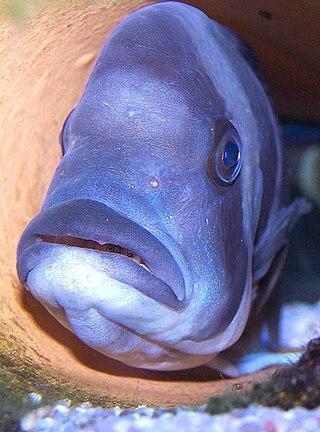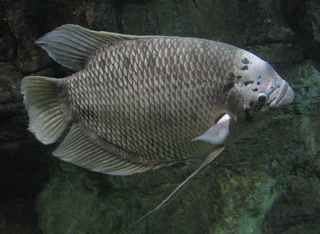
Mouthbrooding, also known as oral incubation and buccal incubation, is the care given by some groups of animals to their offspring by holding them in the mouth of the parent for extended periods of time. Although mouthbrooding is performed by a variety of different animals, such as the Darwin's frog, fish are by far the most diverse mouthbrooders. Mouthbrooding has evolved independently in several different families of fish.

Gouramis, or gouramies, are a group of freshwater anabantiform fish that comprise the family Osphronemidae. The fish are native to Asia—from the Indian Subcontinent to Southeast Asia and northeasterly towards Korea. The name "gourami", of Indonesian origin, is also used for fish of the families Helostomatidae and Anabantidae.

Léon Louis Vaillant was a French zoologist. He is most famous for his work in the areas of herpetology, malacology, and ichthyology.

The chocolate gourami is a species of gourami native to the Malay Peninsula, Sumatra, and Borneo. Chocolate gouramis reach a length of 6 cm (2.4 in). These fish have a chocolate colour with golden bands running down their bodies.

Trichogaster is a genus of gouramis native to South Asia from Pakistan to Myanmar. It is the only genus in the monotypic subfamily Trichogastrinae as set out in the 5th Edition of Fishes of the World, although that book states that there are two genera, the other being Colisa which is treated as a synonym of Trichogaster by Fishbase and the Catalog of Fishes. Fishbase also places the genus in the Luciocephalinae. Species of this genus are very popular in the aquarium trade.

Osphronemus is a genus of large gouramis, the only genus within the subfamily Osphroneminae. These fish are known as the giant gouramis and are native to rivers, lakes, pools, swamps and floodplains in Southeast Asia, with O. exodon from the Mekong basin, O. laticlavius and O. septemfasciatus from Borneo, while O. goramy is relatively widespread. O. goramy has been introduced outside its native range in Asia, Africa and Australia.

The snakeskin gourami is a species of gourami native to Southeast Asia. Prior to the merging of Belontidae to the family Osphronemidae, the snakeskin gourami was regarded as the largest member of its family. It is still the largest species in its genus and subfamily.

Trichopodus is a genus of tropical freshwater labyrinth fish of the gourami family found in Southeast Asia. Gouramis of the genus Trichopodus are closely related to those of Trichogaster ; species of both genera have long, thread-like pelvic fins used to sense the environment. However, Trichopodus species have shorter dorsal fin base and, when sexually mature, are much larger, with the largest, the snakeskin gourami, capable of reaching a length of over 8 in (20 cm).

Parosphromenus is a genus of gouramies native to freshwater in Southeast Asia. All species are highly specialized peat swamp inhabitants native to southeast Asia, and the males are usually brightly colored in breeding dress; however, their need for soft, acidic water and live food prohibits the genus from becoming popular aquarium fish.

Betta is a large genus of small, active, often colorful, freshwater ray-finned fishes, in the gourami family (Osphronemidae). The best known Betta species is B. splendens, commonly known as the Siamese fighting fish and often kept as an aquarium pet.

Luciocephalus pulcher, the pikehead, giant pikehead or crocodile pikehead, is a species of gourami native to the Malaya Peninsula, Sumatra, and Borneo. It is a yellowish-brown fish with dark brown longitudinal bands and stripes, and can reach a length of 20 centimetres (7.9 in) SL.
Anchoviella is a genus of anchovies, native to coastal parts of the tropical western Atlantic and eastern Pacific oceans, as well as rivers in South America.

Trichogaster fasciata, the banded gourami or striped gourami or Colisa or Kholshe, is a tropical labyrinth perch found in some Asian countries like Bangladesh, Eastern India, Northeastern India, Nepal, Upper Myanmar, China and Pakistan.

The giant gourami is a species of large gourami native to freshwater habitats in Southeast Asia. It has also been introduced elsewhere. The species is commercially important as a food fish and is also farmed. It can be found in the aquarium trade, as well. The species has been used for weed control on highly invasive aquatic plants like Salvinia molesta, as the giant gourami can be a voracious herbivore.

The Anabantiformes, collectively known as labyrinth fish, are an order of air-breathing freshwater ray-finned fish with two suborders, five families and having at least 207 species. In addition, some authorities expand the order to include the suborder Nandoidei, which includes three families - the Nandidae, Badidae and Pristolepididae - that appear to be closely related to the Anabantiformes. The order, and these three related families, are part of a monophyletic clade which is a sister clade to the Ovalentaria, the other orders in the clade being Synbranchiformes, Carangiformes, Istiophoriformes and Pleuronectiformes. This clade is sometimes referred to as the Carangaria but is left unnamed and unranked in Fishes of the World. This group of fish are found in Asia and Africa, with some species introduced in United States of America.
Betta akarensis, the Akar betta, is a species of gourami endemic to south-east Sarawak, and whose species name akar was so named after where it was originally found in the river Sungai Akar. This species is a mouthbrooder, and grows to a length of 10 centimetres (3.9 in) SL. According to Linke, they "live predominantly in mineral-poor, slightly acid water enriched with humic substances".

Luciocephalinae is a subfamily of the gourami family Osphronemidae. The members of this subfamily differ from the other groups within the gourami family by having a reduced number of rays supporting the branchiostegal membrane, five rather than six, and in the possession of a median process of the basioccipital which reaches the first vertebra and which has an attachment to the Baudelot's ligament.

The threestripe gourami, also known as the Mekong croaking gourami, is a species of freshwater ray-finned fish from the subfamily Macropodusinae which is part of the gourami family Osphronemidae. It is native to south-east Asia.
Sphaerichthys acrostoma, sometimes known as the giant chocolate gourami, is a species of gourami. It is native to Asia, where it is known only from the Kalimantan region of Borneo in Indonesia. The species reaches 4.6 cm in standard length, although some sources report a maximum standard length of 7 cm. It is known to be a facultative air-breather, and females of the species exhibit mouthbrooding.
Sphaerichthys vaillanti, known as Vaillant's chocolate gourami, Samurai gourami, or Samurai zebra gourami, is a species of gourami. It is native to Asia, where it is known from mainly the Kapuas river in the west Kalimantan, [1], region of Borneo in Indonesia. It is generally seen in pairs in small creeks or drainage where wood debris is abundant. It is known to mimic dead leaves as a form of camouflage. The species reaches about 6 cm in standard length and is known to be a facultative air-breather.














